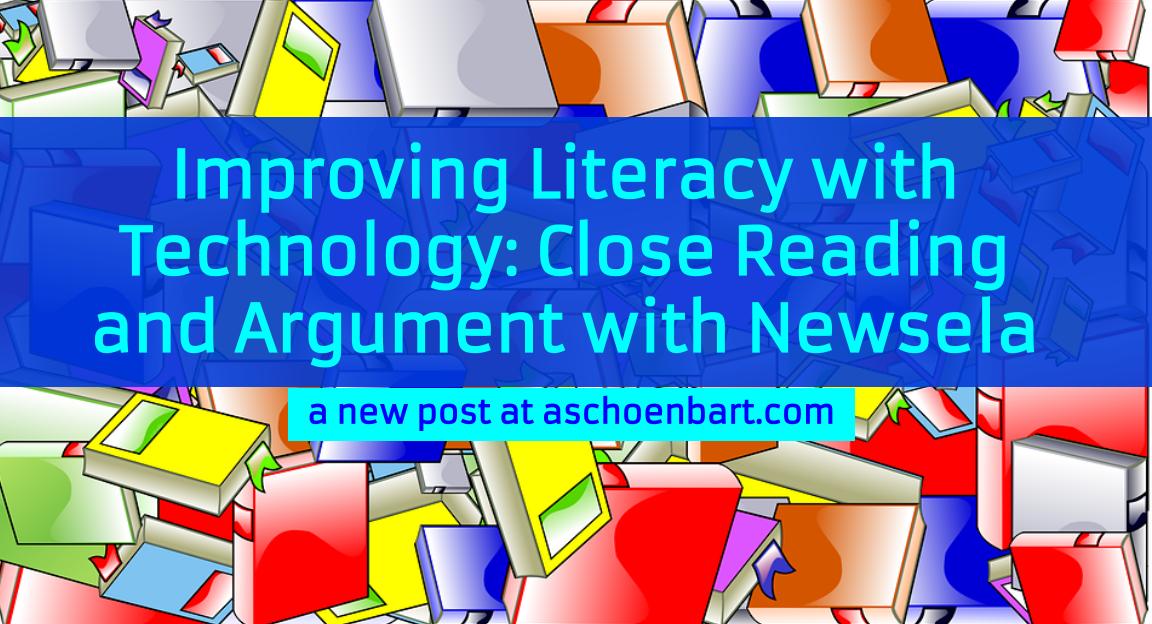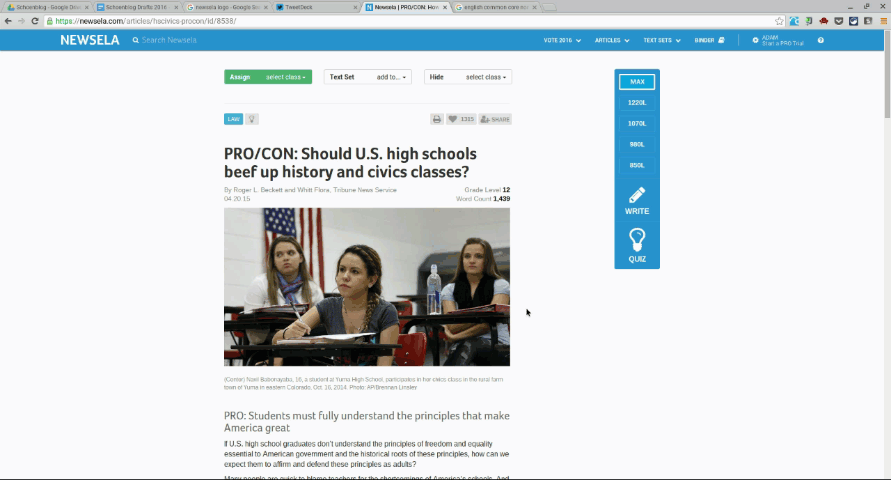Improving Literacy with Technology: Close Reading and Argument with Newsela


I started this week with a challenge to myself: I needed to do more to help my students practice close reading and make progress in argumentative writing. A few months ago, my students were producing interesting and often insightful paragraphs, essays, and projects--and most were well written. I was happy with the growth and journey.
Now, in the slump of spring beginnings and after the dark days of winter, it’s time to tighten up. My kids are great and are more than capable, but I needed them to review the fundamentals and practice the writing and analysis skills, which were getting a little lax of late.
I was looking for resources to help my students achieve two main goals:
- Practice close reading through non-fiction reading and answer multiple choice questions
- Develop arguments through good writing
I had hoped to find interesting or controversial texts and to keep them sort. With a week or two of low stakes practice, collaboration, and revision, we would be ready for the next level of sophistication and analysis.
Lucky for me, I found Newsela.
It’s rare that I write a whole post plugging just one piece of tech, tool, or strategy, but this week I fell in love with this website because of how well it integrates technology with meaningful instructional practices. My goals above didn’t need to involve technology but Newsela helps me use tech to augment my practices and enhance students learning in ways that were much harder before.

Why Newsela?
Newsela describes itself as “an innovative way to build reading comprehension with nonfiction that's always relevant: daily news. It's easy and amazing.”
Tools and ideas to transform education. Sign up below.
The website is filled with relevant and interesting non-fiction articles that can be sorted by topic or grouped by thematic text sets. With the click of a button, a user can adjust the lexile level and differentiate the difficulty of the reading. There are also challenging multiple choice questions that accompany each piece. The questions and overall word count change as you switch between the 5 different levels.
Common Core-read nonfiction differentiated with technology? Now this is cool.
The Freemium Warning
I was a little confused about what I could and couldn’t do on Newsela for free. By creating a free account or logging in with my GAFE account, I was easily about to find, save, adapt, and download articles.
With a paid account you can do so much more, including assigning articles to students through class groups on Newsela or through Google Classroom. This feature sounds fantastic for a Google school or power user, but I’m sticking to the free account right now and am pretty impressed by it.

The Lesson
I found my high-interest article and the rest fell into place quickly. I asked students to read and annotate the article, “PRO/CON: How can we improve U.S. history and civics classes?” After a close reading, they would craft an argument about whether or not changes were necessary for history classes supported by the text.
With this assignments, students are close reading, annotating, developing argumentative claims, using and citing textual evidence, and more. Plus there’s the writing skills involved. Later, they will peer edit, revise, and publish online.
For this lesson, I decided that the differentiation technology would help me assign appropriate texts to each student. To that end, I printed copies of the article at different lexile levels and assignment them to students as appropriate. I want my students to read, annotate, and outline on paper before typing their responses. Lately, I’ve noticed that technology has led some to jump the gun on writing more quickly, without enough thought to planning and organization.
In the future, though, I can envision students choosing and differentiating their own texts.
The Core Connection
Wherever you teach, you have standards and tests. No matter what you and I think of them, it’s a reality of our world.
In New York, that test is the Common Core ELA Regents, which has three sections: multiple choice reading comprehension, an argumentative text-based essay, and a short text-based response.
Newsela and this assignment really help me prepare students for all of them, but more importantly, they help build essential skills and use the technology to enhance and augment the differentiation and practice that my students needs.
Next month, I plan to use a Newsela text set for the full argumentative essay task for even stronger practice.
Reviewing the Standards
To refresh my own knowledge of the Common Core Standards, I did a quick review at CoreStandards.org. At a minimum, this one lesson satisfies RI.9-10.1, 2, 8, 10, and W.9-10.1.ABCDE, 4, 5, and 6.
Newsela is a good tool and I think this is a good lesson, with or without the Common Core. But being able to support my instructional choices can only help. In particular, these two “power standards” guide this lesson and learning:
- CCSS.ELA-LITERACY.RI.9-10.8: Delineate and evaluate the argument and specific claims in a text, assessing whether the reasoning is valid and the evidence is relevant and sufficient; identify false statements and fallacious reasoning.
- CCSS.ELA-LITERACY.WHST.9-10.6: Use technology, including the Internet, to produce, publish, and update individual or shared writing products, taking advantage of technology's capacity to link to other information and to display information flexibly and dynamically.
Technology on its own is an expensive and shiny distraction from learning. But when it’s driven by good practice to augment and transform teaching and learning, it’s incredibly powerful.
When I can combine my district’s literacy initiative, effective technology implementation, Common Core instruction, and challenging but relevant reading and writing, it’s a wonderful combination of technology and learning.
Thanks, Newsela for this cool tool to make it easier for me to help my students grow.
What are your favorite tools for enhancing literacy or writing instruction? Share your thoughts on Newsela, this lesson, and the combination of literacy and technology instruction in the comments or on Twitter.
cross posted at www.aschoenbart.com
Adam Schoenbart is a high school English teacher, Google Education Trainer, and EdD candidate in Educational Leadership. He teaches grades 10-12 in a 1:1 Chromebook classroom at Ossining High School in Westchester County, NY and received the 2014 LHRIC Teacher Pioneer Award for innovative uses of technology that change teaching and learning. Read more at The SchoenBlog and connect on Twitter @MrSchoenbart.
